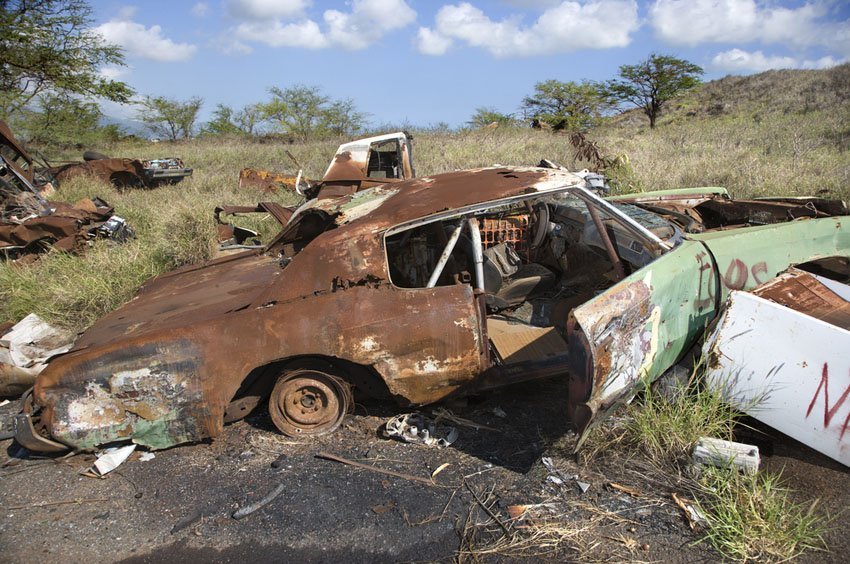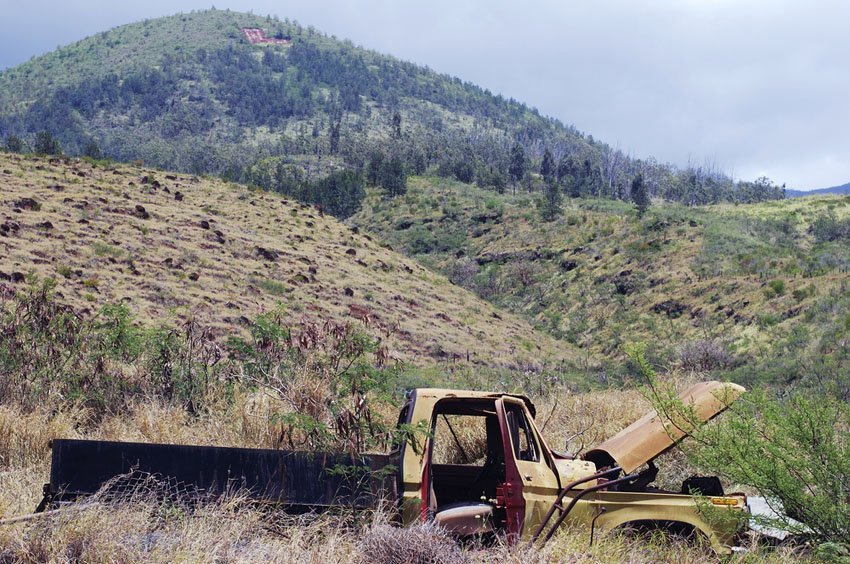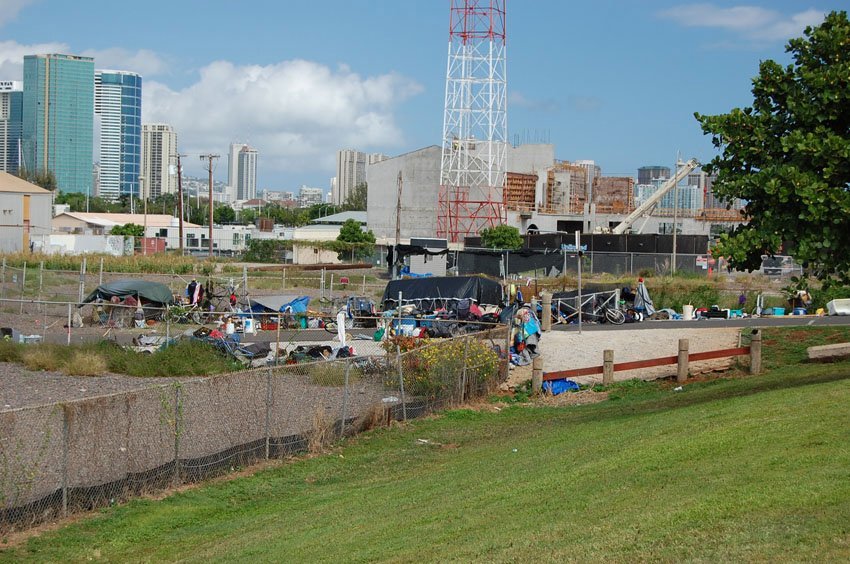Troubles in Hawaii
Even though Hawaii is a visitor magnet and more and more people are coming to the islands each year, paradise also has its downside. Here is a list of some island troubles - challenges, the islands and its people struggle with.
Cost of Living in Hawaii
Hawaii residents often times complain about the islands' high cost of living. When compared to the continental United States, the differences are indeed stunning. Everyday things, such as groceries, cost an average of 30 percent more in Hawaii than on the Mainland. One might think that this is due to high shipping costs (since most of the food available in the islands is brought here on ships and airplanes). But this is not the main reason. Shipment is only a minor factor, adding perhaps no more than five percent to the retail price of food. A much bigger factor is the need for grocers to maintain larger inventories in order to keep things on the shelves at all times. (Grocers on the Mainland are much closer to the food source). Also, retailers here pay a lot more for the use of land and buildings than on the Mainland. Another factor is Hawaii's four percent excise tax, which adds on to the total cost of things.
However, the main culprit that makes living in Hawaii expensive is the high cost of housing. In 2011, the average cost for a single-family home on the island of Oahu was $707,402 (the median sale price was $575,000), according to the Honolulu Board of Realtors. Condos sold for an average of $357,881 (median sale price was $300,000). This is considerably higher than the housing cost in most cities on the Mainland. And it's not only houses and condos that are expensive. Rent is too. On Oahu, for example, the monthly rent for a studio ranges from $700 to $1,200 and up. It is almost impossible to find a studio under $700. Two-bedroom apartments start at around $1,000 and up, depending on the location.
There are several reasons why housing is so expensive in Hawaii. One factor is the limited amount of land onto which the cities could expand. Another reason is the higher construction costs that are due to high shipping and inventory costs of the material and excise taxes among others. Furthermore, housing is usually more expensive in attractive places to live, where the quality of life is good. Hawaii has several desirable qualities, such as clean air and water, a pleasant climate, forests, mountains, the ocean, a culturally diverse population and a wide variety of restaurants and nightlife.
Population Size
There were 1,374,810 people (2011 estimate) living in Hawaii, not including tourists. In 2011, Hawaii's population density was 214 people per square mile (82.6 people per sq. km). And on Oahu, where the majority of Hawaii residents live, the population density was even higher - 1,468 people per square mile (567 people per sq. km). In comparison, the total population density of the United States was 88 people per square mile (34 people per sq. km) in 2010. Hawaii is the 13th most densely populated state in the U.S. Often times in daily life, one can get a crowded feeling in Hawaii, especially on Oahu, which has its nickname of the "Gathering Place" for a reason. This is especially evident during rush hour on weekdays.
Traffic Congestion
Hawaii residents and visitors alike frequently complain about bad traffic. It's one of the biggest complaints one hears in the islands. Traffic is at its worst during the morning and afternoon rush hours. On Oahu, the H1 and H2 highways, on Maui the Honoapiilani Highway (Hwy 30) and on Kauai the Kuhio Highway (Hwy 56) around Lihue, are often times completely jammed during those times and more often even outside of the regular rush hours.
There are two main reasons that account for the islands' packed roads. The first is the number of cars in the islands. There are more than one million registered motor vehicles in the state. However, it's not just the high number of vehicles that account for congested roads. Hawaii's total number of lane miles (total length of all roads) is 1,102 miles (1,773 km). There is no state in the United States with fewer lane miles. Even Puerto Rico with its 3,459 square miles (8,959 sq. km) of land has more road miles than Hawaii, which has 6,422 square miles (16,633 sq. km) of land. So in other words, Hawaii's roadway system is under-built. On a per capita basis, the state of Hawaii has fewer roadway miles than anywhere in the United States.
The state is trying to relieve traffic congestion by various means, including contraflow lanes, HOV (high-occupancy vehicle) lanes, which are lanes for vehicles with a driver and one or more passengers, coordinated signals, widening existing roads and improving public transportation services. These improvements have so far been short-lived and didn't solve the problem permanently.
There's an ongoing debate on what measure need to be taken to solve the traffic issue in Hawaii. Some people argue that Hawaii, and mainly Oahu, need a better mass transit system, such as a fixed-rail system. Others say that only a market approach could solve the problem, which could be in the form of fees for the usage of certain roads at certain times of the day, or an increase in gasoline taxes.
Junk Cars
Abandoned junk cars are a state-wide problem in Hawaii. No matter where you are, on Oahu, Maui, Kauai or the Big Island, you can see old cars sitting on the street sides, in someone's backyard, dumped over cliffs, or left somewhere in the forest. Many of them sit there for years, quietly falling apart and rotting away. Sometimes you can only guess that a metal piece of junk has once been a car. Bushes are finding its way through the metal and grass is growing on its seats and dashboard.
But often times before an old car starts its rotting process, "thieves" (or better said people in the open car market) will visit it and take all that might still be of value. It might be a junk car, but it still has parts. This usually happens as soon as an old car appears abandoned.
Not only are junk cars ugly to look at and make paradise look bad, they are also an environmental and safety hazard due to leaking petroleum and other fluids. It also takes many years for metal to completely rot away. Car batteries and tires take even longer. Junk vehicles also collect sitting water, which provides a breeding ground for insects and other pests, such as rats, parasites and lice, which might transmit various diseases to humans.
Even though there is a fee for abandoning ones junk car, people still seem to do it. It's not that there are no ways to get rid of ones old car in an environmentally friendly way. There are several businesses that offer to tow an old car (but one that still has all of its parts) for free. The problem just is that once the car is stripped from its parts that might still have some value, one can't donate it to these kinds of charitable organizations anymore.
Homelessness
Besides Hawaii being a favorite residency and vacation spot for many people, the islands also have a large homeless population. Homeless people in Hawaii have set up camp in many places - in beach parks, under highway overpasses, under portable school buildings, under trees and in other places. Others live in their cars, often times entire families, or in tents on the more isolated beaches. Some homeless have all their belongings in large backpacks or push them around in shopping carts.
The number of homeless people in Hawaii has increased by 61 percent since 2000. Currently, more than 6,000 people live on the streets in the entire state. According to U.S. Census data, the state's increase in poverty is among the highest in the nation. About 11.5 percent of Hawaii's population is living in poverty. Even though Hawaii has a warm climate year-round and there could be worse places to be homeless, rape and robbery still exist and are a threat to homeless people.
Homelessness in Hawaii is blamed on a variety of factors. One, that is the same as on the continental United States, is the federal Welfare Reform Act of 1994, which limits families to five years of welfare benefits. Other local factors include the high cost of living and housing, the lack of affordable homes, drug problems and deficient mental health programs and facilities.
The state is trying to alleviate the homeless problem, but it doesn't seem to be easy or go quick enough. In 2005, the Department of Housing and Urban Development awarded almost $6 million in grants to aid Hawaii's homeless. The money was distributed among several agencies and programs, from homeless shelters to drug treatment facilities. A plan to create a "tent city" near Waianae on Oahu's leeward coast was abandoned because of protests from the resident population, who were afraid that this would lead to an increase in the crime rate.
Drug Epidemic
Drug abuse is a major cause of crime in Hawaii. In 2001, drug convictions made up 50.4 percent of all total criminal convictions in the state. This is above the national average of 41.2 percent. Methamphetamine (commonly knows as crystal meth or "ice") is the most commonly used drug in Hawaii. Of all criminal convictions that were related to drug abuse, crystal meth made up 51.1 percent of all cases.
Crystal meth is known to be a highly addictive stimulant. It's a synthetic drug that can cause strong feelings of euphoria, but also unpredictable behavior, depression and hallucination. As the drug wears off, one may experience physical weakness and a strong "come-down" effect.
Crystal meth use in Hawaii is not a recent problem. It started in the late 1970s, but since then, the number of people smoking "ice" has steadily increased. Social workers have predicted that if crystal meth use keeps on increasing at the current rate, every person in Hawaii will eventually be affected by the drug, either directly (smoking it him-/herself) or indirectly (through a theft, car accident caused by the drug, or a family member involved in the drug).
There is no scientific data on the number of people using crystal meth in Hawaii. However, more than 2,730 people sought treatment for their crystal meth addiction in 2002, accounting for more than the number of people seeking treatment for alcohol and marihuana combined.
Noise
Some areas in Hawaii can be quite noisy, mainly parts on Oahu, where the majority of the people live. Honolulu and Waikiki are large metropolitan areas with plenty of people and cars. Large cities tend to be noisy and so are Hawaii's big cities. In the last decades, the construction boom has contributed to a lot of noise. New shopping centers, apartment complexes and hotels were built all around town. The thing with construction sites is that they are loud.
Another noise factor is car alarms. Residents in Waikiki and other parts of the island (Oahu and other Hawaiian Islands as well) often times complain that car alarms set off for no reason. Sometimes it's already enough when a big truck or a motorbike with a loud engine drives by causing the car alarms of parked cars to go on because of the passing vehicle's motor vibrations. Car alarms are heard so frequently in Hawaii that they already lost their sole purpose of alarming nearby people that a car is being stolen. Nobody seems to pay attention anymore when they hear just another annoying car alarm.
Garbage trucks can also be a pain for one's ears. Often times, they can already be heard early in the morning, even in residential neighborhoods, picking up the trash. What is worse is that it's not only their loud motor. In order to pick up the large dumpsters, they need to drive backwards, which causes the vehicle to beep as a safety precaution. This beeping is like one's alarm clock and even worse if you hear it earlier than you had planned to wake up.
High Electricity Costs
In 2010, Hawaii had the highest electricity rates in the nation. As the price for crude oil spiked in 2008, so did the electricity costs in Hawaii. That's because petroleum fuels 76 percent of the state's electrical generators, which is more than any other state in the nation. Because of Hawaii's reliance on petroleum, residents of the islands pay such a high price for electricity. In 2010, Hawaii residents paid 25.1 cents per kilowatt-hour, while the national average was 9.8 cents. A decade earlier, in 2000, Hawaii residents paid 14 cents per kilowatt-hour for electricity. Hawaii residents and building owners have to find new ways to reduce their energy costs.
Other Troubles
Murder is less of an issue in Hawaii than on the Mainland. It does happen, as does rape and violent assault, but the most common types of crime in Hawaii include car and apartment/house break-ins, stolen cars and purse snatchings.
Another state-wide problem is where to dump our garbage. Hawaii landfills are almost full. There has been an ongoing debate whether to create a new landfill on Oahu's leeward coast or if it's a better idea to ship the garbage to the Mainland. The problem in Hawaii is to find a suitable landfill so that it doesn't contaminate the groundwater. And there are hardly any suitable places.
































